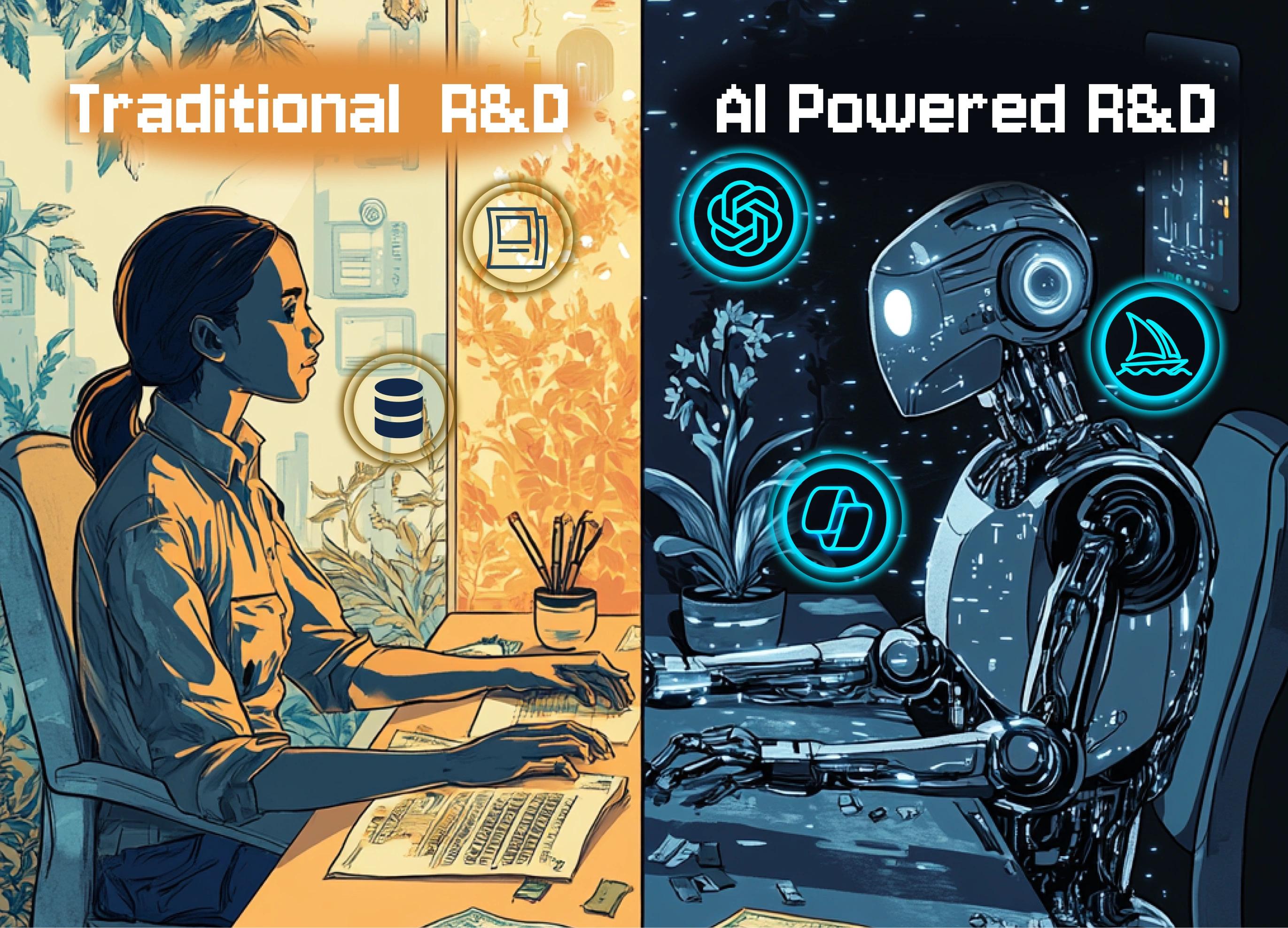Have you ever wondered why, despite investing significant time and resources into R&D, your company still struggles to stay ahead in a rapidly changing market? The pressure to innovate faster is relentless, yet traditional methods seem to be slowing you down rather than speeding up progress.
Your competitors are tapping into the latest R&D technologies like artificial intelligence, machine learning, advanced data analytics, and rapid prototyping and you can’t help but think:
What’s missing from our approach?
This is the dilemma many enterprise leaders like yourself face today. The pace of technological advancements is accelerating, and while the potential for breakthroughs is enormous, your current R&D methods may be limiting your company's ability to fully capitalize on these opportunities. This is where AI-powered Innovation Labs come in.

Progression from Manual R&D to AI-driven Innovation
The Old Guard vs. The New Frontier: A Paradigm Shift in R&D
Traditional R&D has served us well for decades. It’s been the backbone of innovation with manual processes, human-led experimentation, and siloed teams. But here’s the catch: it’s slow. Really slow. We’re talking 3-5 years for a single innovation cycle. And it’s expensive—tons of resources tied up in trial-and-error, hoping to land on something that works.
Now imagine this: AI-powered innovation labs.
- Think about all those repetitive tasks like data collection and analysis. With AI, they’re gone. For example, a pharmaceutical company cut its data processing time by 30%, letting researchers focus on breakthroughs, not busy work.
- Generative AI can slash prototyping time. A car manufacturer recently reduced its concept-to-prototype cycle from 6 months to just 10 weeks. Can you believe that?
- Reinforcement Learning algorithms predict outcomes with up to 95% accuracy. Imagine launching a product with near certainty it will succeed. That’s not just saving money—it’s de-risking innovation altogether.
This is more than evolution—it’s a revolution. AI isn’t just helping us move faster; it’s completely changing the game. It’s taking us from trial-and-error to data-driven precision.
Think About It: If your competitors are deploying AI to deliver faster, cheaper, and more innovative solutions, what happens to your market share if you stick with the old ways?

Traditional R&D and AI-Powered R&D
What Are AI-Powered Innovation Labs?
AI-powered innovation labs are no longer just futuristic ideas—they’re a reality, revolutionizing how businesses approach research and development. But what exactly are they?
Think of them as advanced workspaces where AI technologies like Generative AI, Machine Learning (ML), and Reinforcement Learning combine with state-of-the-art tools and human expertise to fast-track innovation.
These labs are designed for agility. They integrate cutting-edge infrastructure like cloud computing platforms and edge AI hardware, making it possible to process massive amounts of data and experiment at scale.
The result? Ideas that would have taken years to materialize are now brought to life in months or even weeks.
Let’s walk through some of the core technologies behind these labs and how they’re redefining innovation.
Generative AI for Accelerated Creation
Let's suppose your product development process, often a months-long journey, now takes half the time—or less. Generative AI uses vast datasets to generate ideas, designs, and prototypes in record time, enabling rapid iterations and continuous improvement.
Marketing teams, for instance, have used tools like GPT-4 to automate personalized content, slashing campaign costs by 30%. What if your product development timelines could also be cut in half, delivering results in weeks instead of months?

Generative AI for Accelerated Creation
Conversational AI for Smarter Collaboration
Instead of hours of back-and-forth discussions, Conversational AI steps in, guiding the conversation, analyzing real-time data, and offering actionable insights.
IBM Watson has already shown how this can reduce meeting times by 20% while improving the quality of decisions. Imagine a brainstorming session where ideas flow effortlessly, decisions are made faster, and your team’s productivity soars.
Reinforcement Learning for Continuous Improvement
Now, think about perfecting a process through Reinforcement Learning (RL)—AI learning through trial and error, improving with every iteration. This is how AlphaFold cracked protein structure predictions, cutting years off drug discovery timelines.
In autonomous vehicles, RL runs thousands of simulations to optimize driving strategies. Applied to your R&D, RL could revolutionize manufacturing workflows, streamline supply chains, or refine product designs, ensuring smarter, faster decisions at every step.
Computer Vision for Perfecting Quality
Finally, let’s talk about Computer Vision—the ability for AI to “see” and understand visual data. This technology is invaluable in industries where precision and quality control are paramount. By analyzing images or videos, Computer Vision can identify defects, monitor production lines, and even guide robots during the assembly process.
Example: In the automotive industry, it detects defects with 95% accuracy, reducing inspection times by 50%. Your business can benefit from fewer errors, faster production cycles, and better products.
The Building Blocks of AI Innovation Labs
Did you know AI innovation labs are more than just spaces filled with fancy tech? They’re where ideas turn into reality and businesses solve problems smarter and faster.

enterprise ai components
Challenges and Solutions: Overcoming Roadblocks in AI Innovation Labs
Let’s be real—launching and managing AI innovation labs comes with its own set of challenges. But don’t worry, we’ve got the solutions to help you navigate these roadblocks and turn them into opportunities. Here’s a breakdown:
1. Struggling with Data Quality and Silos?
How often has poor data quality hindered your projects? Many AI initiatives fail due to fragmented data spread across disconnected systems, leading to incomplete insights.
- Solution: We specialize in creating integrated data ecosystems using Google Cloud's capabilities, eliminating silos and ensuring seamless, high-quality data pipelines. Our Human-AI Partnership approach ensures that your data management system supports your innovation every step of the way.
2. Feeling the Talent Crunch?
Finding AI experts can feel like searching for a needle in a haystack, right? Did you know only 15% of companies have the skilled talent they need in-house?
- Solution: Whether it’s consulting or hands-on implementation, we ensure your team is ready to adapt to AI innovation. With Customized AI Solutions tailored to your unique needs, we help bridge the talent gap and drive your AI initiatives forward.
3. Worried About AI Bias and Ethics?
Ever wondered how much damage a biased AI model can do? Amazon learned it the hard way with their flawed hiring tool.
- Solution: We implement rigorous testing frameworks and ethical guidelines to ensure transparency, fairness, and compliance with global regulations, ensuring your AI models build trust and operate ethically. We incorporate White-Glove Science, guaranteeing careful consideration of ethical concerns throughout the development process.
4. Struggling to Scale Your AI Efforts?
You’ve nailed the pilot project, but scaling it enterprise-wide feels like climbing a mountain, doesn’t it?
- Solution: With cloud-native tools like Google Cloud infrastructure, we make scalability seamless and cost-efficient. We integrate Human-AI Partnerships into your scaling efforts, ensuring that your AI solutions grow with your business while staying customizable and effective.
The Future of AI-Powered Innovation Labs
What’s next? AI innovation labs are just scratching the surface. Here’s what the future holds:
The future of AI-powered innovation labs is closer than you think, and it’s changing the game for businesses like yours.
AI and IoT-powered labs running experiments around the clock, cutting down on human intervention. By 2025, 75% of enterprises will be moving toward hyper-personalized R&D, delivering solutions tailored specifically to their customers.
And here’s the exciting part—open AI platforms will make these advanced tools accessible to businesses of all sizes, leveling the playing field. How do you see your business tapping into this next wave of innovation?

Is Your Enterprise Ready for the Future?
AI technologies like Generative AI, Reinforcement Learning (RL), and NLP are transforming R&D. Unlike traditional methods that rely on trial and error, these AI tools process vast data quickly, generate solutions, and predict outcomes with unmatched precision.
Imagine your R&D team testing and refining product concepts in weeks instead of months, all while cutting costs. The real question is: Could AI help your team innovate faster, smarter, and more cost-effectively? It's not a distant future—it’s happening now. Let’s explore how we can turn your R&D challenges into your biggest strengths.


